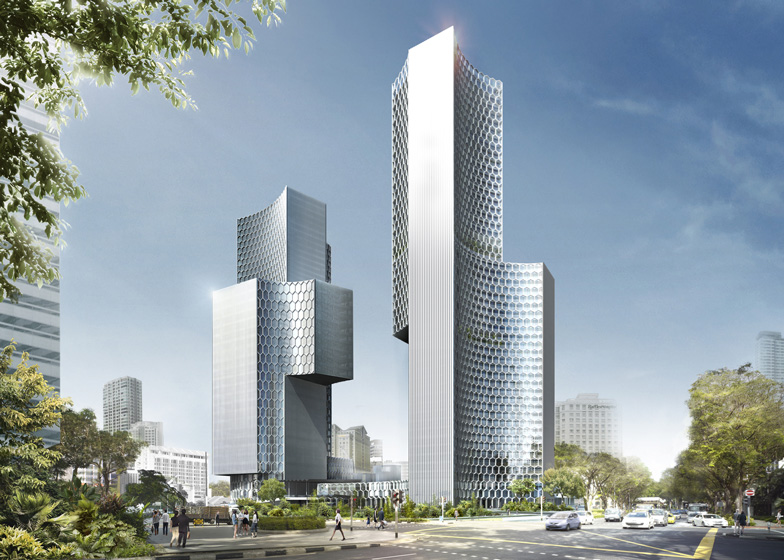Buro Ole Scheeren has unveiled a pair of skyscrapers with concave walls for Singapore's historic Kampong Glam district.
Buro Ole Scheeren has designed the twin DUO towers to have heights of 186 and 170 metres, with the former to contain over 600 apartments, while the latter will accommodate offices and a hotel.
The building will sit between the city's commercial district and the Kampong Glam area, which was once home to the Malaysian aristocracy and today contains a mix of Malay and Muslim communities.
A hexagonal pattern of windows will cover the facades of the towers and floors will step back and forth using a system of cantilevers.
Both towers will feature concave walls, which will frame the outlines of public spaces and gardens at ground level.
Shops will line the base of these elevations, while pedestrian routes will link up with the metro station nearby.
The architect's proposals also include a rooftop restaurant and a public observation deck.
Construction is scheduled to start in 2013, with completion pencilled in for 2017.
Above: building layout - click above for larger image
Ole Scheeren set up his studio in September 2010 after 15 years of working alongside Rem Koolhaas at OMA, where he worked on the CCTV Headquarters building that completed in Beijing earlier this year.
Above: site plan - click above for larger image
Since then, the studio has also revealed plans for a skyscraper in Kuala Lumpur, which you can read about in our earlier story.
Above: proposed massing elevations
Find out more about Ole Scheeren »
Here's the full press release from the architects:
Buro Ole Scheeren unveils design for twin towers DUO in Singapore
The design for this Malaysian-Singaporean joint venture actively engages the space of the surrounding city to form a new civic nucleus in Singapore’s modern metropolis. The two towers are not conceived as autonomous objects, but defined by the spaces they create around them.
Singapore consistently ranks as one of Asia’s most livable cities. However, it is increasingly dominated by isolated individual towers that favor exclusion over social connectivity. The prescribed zoning confronts the project with a dual dilemma: it splits the site into two separate pieces, and leaves large, bulky footprints for the resulting tower envelopes which risk overpowering the surroundings and the intimate scale of the adjacent historic Kampong Glam district.
Above: concept diagram
The design for DUO subtracts circular carvings from the allowable building volumes in a series of concave movements that generate urban spaces – a kind of “urban poché” that co-opts adjacent buildings and symbiotically inscribes the two towers into their context.
By generating the massing through a subtractive process, the elevations of the new towers are reduced to slender profiles. Vertical facades rise skywards along the adjoining roads, while a net-like hexagonal pattern of sunshades reinforces the dynamic concave shapes. The duo of tower volumes is further sculpted to feature a series of cantilevers and setbacks that evoke choreographed kinetic movements of the building silhouettes.
Above: concept diagram
The buildings dematerialize as they reach the ground to provide a porous permeable landscape traversing the site. Leisure zones and gardens act as a connector between multiple transport hubs and establish a flow of tropical greenery and lively commercial activity, accessible to the public 24 hours a day. A plaza, carved into the center of the towers and integrating the neighboring building as part of its perimeter, forms a new public nexus between the historic district of Kampong Glam and the extension of the city’s commercial corridor.
Above: concept diagram
Multiple levels of vertical connectivity give access to large elevated terraces for the hotel and residents, a public observation deck and a sky restaurant atop the office/hotel tower, while establishing a direct connection to the adjacent underground MRT subway station. Vehicular traffic is lifted off the ground to allow uninterrupted pedestrian circulation. Extensive landscape areas at the ground levels, elevated terraces, and roofscapes provide accessible green space equal to 100% of the site area.
Above: concept diagram
The development incorporates environmental strategies through passive and active energy efficient design and naturally ventilated spaces. The building’s orientation is optimized to prevailing sun and wind angles, while the concave building massing captures and channels wind flows through and across the site, fostering cool microclimates within the shaded outdoor spaces.
Embracing civic spaces in a symbiotic relationship with each other and thereby transforming the surrounding multivalent urban fabric, the two sculpted towers act as urban space generators.

